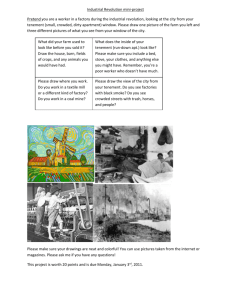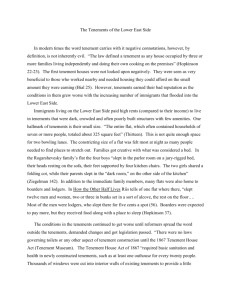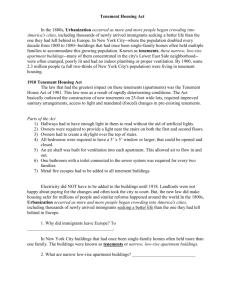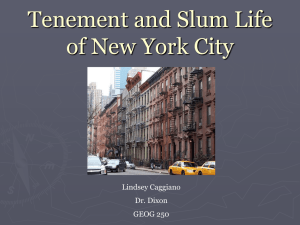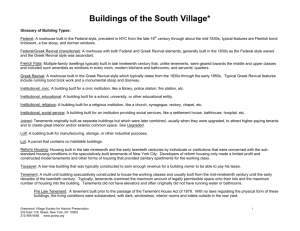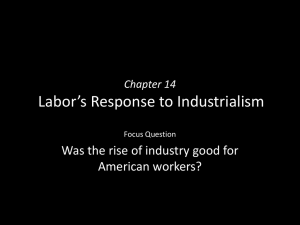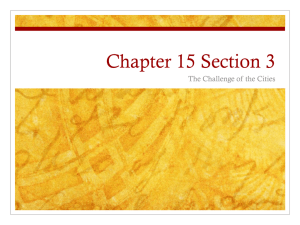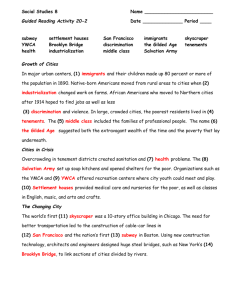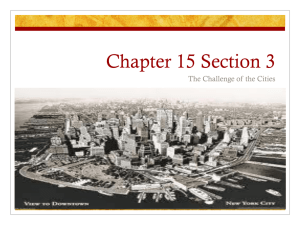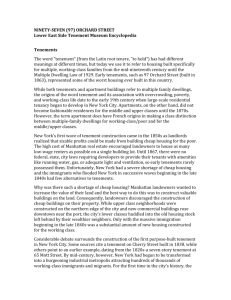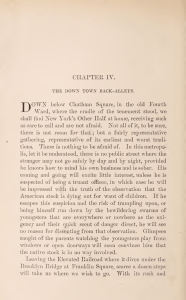How the Other Half Lives PSD Homework
advertisement
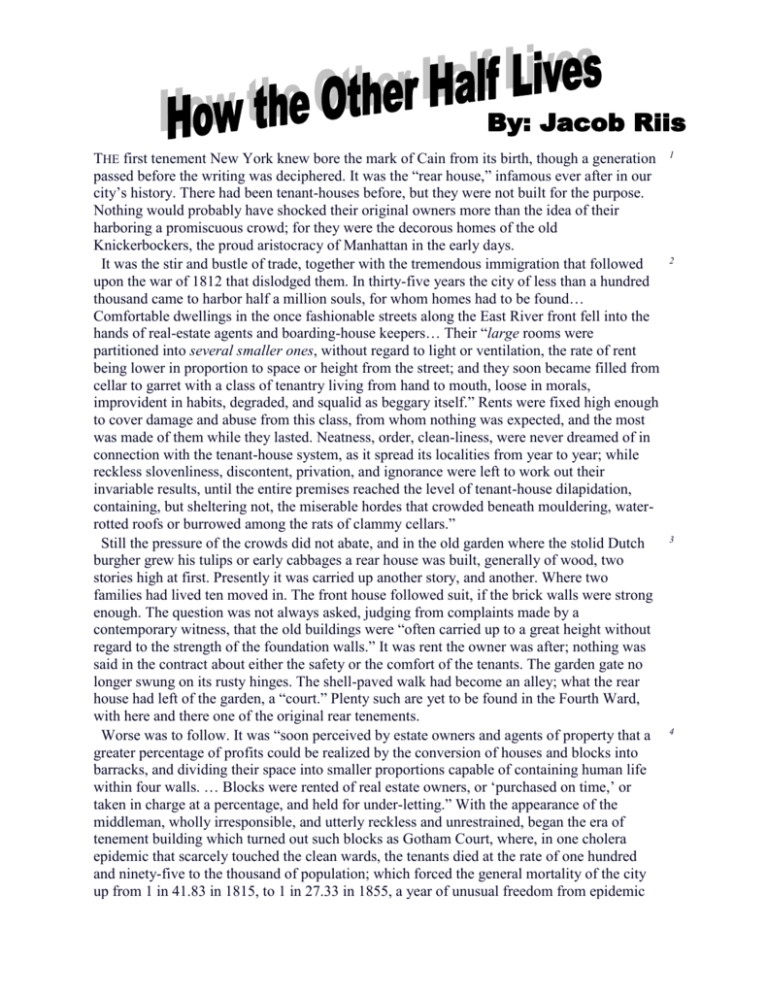
THE first tenement New York knew bore the mark of Cain from its birth, though a generation passed before the writing was deciphered. It was the “rear house,” infamous ever after in our city’s history. There had been tenant-houses before, but they were not built for the purpose. Nothing would probably have shocked their original owners more than the idea of their harboring a promiscuous crowd; for they were the decorous homes of the old Knickerbockers, the proud aristocracy of Manhattan in the early days. It was the stir and bustle of trade, together with the tremendous immigration that followed upon the war of 1812 that dislodged them. In thirty-five years the city of less than a hundred thousand came to harbor half a million souls, for whom homes had to be found… Comfortable dwellings in the once fashionable streets along the East River front fell into the hands of real-estate agents and boarding-house keepers… Their “large rooms were partitioned into several smaller ones, without regard to light or ventilation, the rate of rent being lower in proportion to space or height from the street; and they soon became filled from cellar to garret with a class of tenantry living from hand to mouth, loose in morals, improvident in habits, degraded, and squalid as beggary itself.” Rents were fixed high enough to cover damage and abuse from this class, from whom nothing was expected, and the most was made of them while they lasted. Neatness, order, clean-liness, were never dreamed of in connection with the tenant-house system, as it spread its localities from year to year; while reckless slovenliness, discontent, privation, and ignorance were left to work out their invariable results, until the entire premises reached the level of tenant-house dilapidation, containing, but sheltering not, the miserable hordes that crowded beneath mouldering, waterrotted roofs or burrowed among the rats of clammy cellars.” Still the pressure of the crowds did not abate, and in the old garden where the stolid Dutch burgher grew his tulips or early cabbages a rear house was built, generally of wood, two stories high at first. Presently it was carried up another story, and another. Where two families had lived ten moved in. The front house followed suit, if the brick walls were strong enough. The question was not always asked, judging from complaints made by a contemporary witness, that the old buildings were “often carried up to a great height without regard to the strength of the foundation walls.” It was rent the owner was after; nothing was said in the contract about either the safety or the comfort of the tenants. The garden gate no longer swung on its rusty hinges. The shell-paved walk had become an alley; what the rear house had left of the garden, a “court.” Plenty such are yet to be found in the Fourth Ward, with here and there one of the original rear tenements. Worse was to follow. It was “soon perceived by estate owners and agents of property that a greater percentage of profits could be realized by the conversion of houses and blocks into barracks, and dividing their space into smaller proportions capable of containing human life within four walls. … Blocks were rented of real estate owners, or ‘purchased on time,’ or taken in charge at a percentage, and held for under-letting.” With the appearance of the middleman, wholly irresponsible, and utterly reckless and unrestrained, began the era of tenement building which turned out such blocks as Gotham Court, where, in one cholera epidemic that scarcely touched the clean wards, the tenants died at the rate of one hundred and ninety-five to the thousand of population; which forced the general mortality of the city up from 1 in 41.83 in 1815, to 1 in 27.33 in 1855, a year of unusual freedom from epidemic 1 2 3 4 disease, and which wrung from the early organizers of the Health Department this wail: “There are numerous examples of tenement-houses in which are lodged several hundred people that have a prorate allotment of ground area scarcely equal to two square yards upon the city lot, court-yards and all included.” The tenement-house population had swelled to half a million souls by that time, and on the East Side, in what is still the most densely populated district in all the world, China not excluded, it was packed at the rate of 290,000 to the square mile, a state of affairs wholly unexampled. Swine roamed the streets and gutters as their principal scavengers. The death of a child in a tenement was registered at the Bureau of Vital Statistics as “plainly due to suffocation in the foul air of an unventilated apartment,” and the Senators, who had come down from Albany to find out what was the matter with New York, reported that “there are annually cut off from the population by disease and death enough human beings to people a city, and enough human labor to sustain it.” And yet experts had testified that rents were from twenty-five to thirty per cent, higher in the worst slums of the lower wards, with such accommodations as were enjoyed, for instance, by a “family with boarders” in Cedar Street..a one room 12 x 12 with five families living in it, comprising twenty persons of both sexes and all ages, with only two beds, without partition, screen, chair, or table.” Lest anybody flatter himself with the notion that these were evils of a day that is happily past and may safely be forgotten, let me mention here three very recent instances of tenement-house life that came under my notice. One was the burning of a rear house in Mott Street, from appearances one of the original tenant-houses that made their owners rich. The fire made homeless ten families, who had paid an average of $5 a month for their mean little cubby-holes. The owner himself told me that it was fully insured for $800, though it brought him in $600 a year rent. He evidently considered himself especially entitled to be pitied for losing such valuable property. Another was the case of a hard-working family of man and wife, young people from the old country, who took poison together in a Crosby Street tenement because they were “tired.” There was no other explanation, and none was needed when I stood in the room in which they had lived. It was in the attic with sloping ceiling and a single window so far out on the roof that it seemed not to belong to the place at all. With scarcely room enough to turn around in they had been compelled to pay five dollars and a half a month in advance. There were four such rooms in that attic, and together they brought in as much as many a handsome little cottage in a pleasant part of Brooklyn. The third instance was that of a colored family of husband, wife, and baby in a wretched rear rookery in West Third Street. Their rent was eight dollars and a half for a single room on the top-story, so small that I was unable to get a photograph of it even by placing the camera outside the open door. Three short steps across either way would have measured its full extent. 5 TENEMENT OF 1863, FOR TWELVE FAMILIES ON EACH FLAT 2 D. dark L. light. H. halls. There was just one excuse for the early tenement-house builders, and their successors may plead it with nearly as good right for what it is worth. “Such,” says an official report, “is the lack of houseroom in the city that any kind of tenement can be immediately crowded with lodgers, if there is space offered.” Thousands were living in cellars. There were three hundred underground lodging-houses in the city when the Health Department was organized. Some fifteen years before that the old Baptist Church in Mulberry Street, just off Chatham Street, had been sold, and the rear half of the frame structure had been converted into tenements that with their swarming population became the scandal even of that reckless age. The wretched pile harbored no less than forty families, and the annual rate of deaths to the population was officially stated to be 75 in 1,000. These tenements were an extreme type of very many, for the big barracks had by this time spread east and west and far up the island into the sparsely settled wards. Whether or not the title was clear to the land upon which they were built was of less account than that the rents were collected. If there were damages to pay, the tenant had to foot them. Cases were “very frequent when property was in litigation, and two or three different parties were collecting rents.” Of course under such circumstances “no repairs were ever made.” The climax had been reached. The situation was summed up by the Society for the Improvement of the Condition of the Poor in these words: “Crazy old buildings, crowded rear tenements in filthy yards, dark, damp basements, leaking garrets, shops, outhouses, and stables 3 converted into dwellings, though scarcely fit to shelter brutes, are habitations of thousands of our fellow-beings in this wealthy, Christian city.” 6 7 Analysis Questions: Why were the tenements first created and from what buildings were they created? How were the people that lived in these tenants described? What were the conditions like in these tenants? What were some of the dangers of living in these tenements? Give two examples of how crowded the tenements were. Why did the owners of these tenements make such a large profit?
